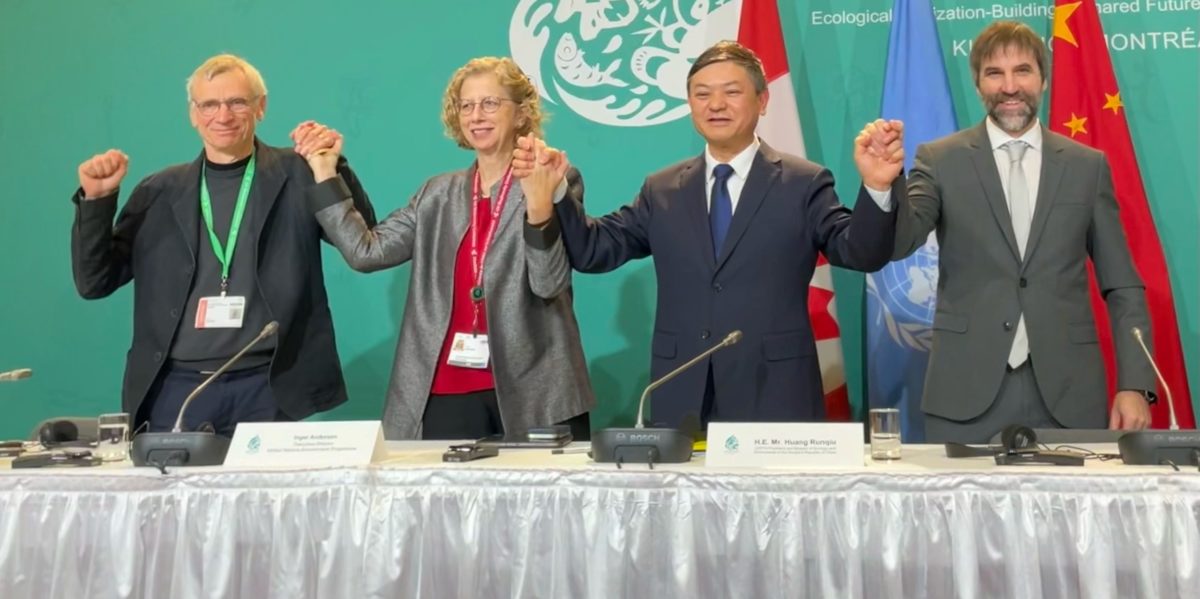A historic and ambitious framework has been reached by 196 nations at COP15 to reverse biodiversity loss and protect 30 per cent of lands and oceans worldwide by 2030.
Currently, 17 per cent of lands and 10 per cent of oceans worldwide are under protection, according to the framework.
More than 12,000 delegates attended the 15th meeting of the Conference of the Parties (COP15) to the United Nations Convention on Biological Diversity.
The agreement, known as the Kunming-Montreal Global Biodiversity Framework, came after 13 days of negotiations that were delayed for two years by the COVID-19 pandemic.
It includes a commitment from governments to respect the rights of Indigenous Peoples and acknowledge the contributions of Indigenous and traditional territories to protect biodiversity.
Along with commitments to reverse biodiversity loss, governments also agreed to eliminate subsidies that are harmful to nature.
On an economic scale, developed countries are expected to contribute $20 billion USD per year until 2025 before increasing to $30 billion until 2030 to help developing countries with their biodiversity frameworks.
The agreement features four goals and 23 targets, including the reduction of pollution to levels that no longer harm biodiversity and ecosystems by 2030, as well as working to eliminate plastic pollution.
One of the targets in the agreement requires governments to reduce pesticides and other hazardous chemical inputs in agriculture, forestry, and other uses by at least 50 per cent by 2030.
In addition to protecting lands and waters, governments committed to cutting food waste in half worldwide while also significantly reducing over-consumption and waste generation of food products.
Putting nature ‘on a path to recovery by 2050’: minister
After reaching the agreement, Minister of Environment and Climate Change Steven Guilbeault compared the magnitude of the framework to the Paris Climate Accord signed by 194 parties in 2015.
“The health of our forests, oceans, animals, and all biodiversity, underpins the very strength and stability of our societies. We cannot take that for granted any longer,” he said in a Sunday statement. “Here in Montréal, we have set a new course. Now it is time to deliver.”
The framework, according to Guilbeault, will put “nature on a path to recovery by 2050.”
“This is a historic moment for nature, and it is our only chance to save what we love and hold dear, before it is too late,” he added.
READ MORE: ‘Canada has a lot on the line’: The future of biodiversity rests on COP15
Guilbeault will have a busy three years ahead, with the federal government committing to protecting 25 per cent of its lands and oceans by 2025.
By 2030, Canada is slated to have 30 per cent of each designated as protected areas, a land mass almost as large as the European Union, according to Guilbeault.
The federal government is set to develop new laws to ensure accountability to biodiversity commitments made at COP15.
Guilbeault also announced that Canada is allocating over $800 million for Indigenous-led conservation efforts, as well as $600 million for international biodiversity finance.
Another $20 million will go towards expanding conservation in the Yukon.
Canada also committed to holding a feasibility assessment with First Nations and the Manitoba provincial government to designate the Seal River Watershed as an Indigenous Protected Area.
“Without such action, there will be a further acceleration in the global rate of species extinction, which is already at least tens to hundreds of times higher than it has averaged over the past 10 million years,” the framework reads.
Environmental groups celebrate ‘win for the planet’
The COP15 agreement to stop and reverse global biodiversity loss by 2030 has been lauded by Canadian environmental groups and experts alike.
“This win for people and the planet will need a whole-of-government and whole-of-society approach to achieve these ambitious goals,” a Monday release from the Canadian Parks and Wilderness Society (CPAWS) reads.
The organization credited Guilbeault, who himself was a climate activist before pursuing a political career, for his leadership in achieving lofty biodiversity agreements on a global scale.
CPAWS National Executive Director Sandra Schwartz is calling on the provinces and territories to work in tandem with the federal government and First Nations to help achieve the land and ocean conservation goals by 2030.
For Gauri Sreenivasan, the Director of Policy and Campaigns with Nature Canada, the country’s national action plan represents a blueprint for other countries to follow suit.
“This historic global deal provides hope that we can collectively halt the planet’s current path towards extinction in a way that centres Indigenous rights and knowledge,” Sreenivasan said in a statement. “Implementation of this agreement will be the crucial issue, and must start now.”
Melanie Snow, a Legislative Affairs Specialist at Ecojustice, says the new agreement “has the potential to reshape the world’s exploitative relationship with nature,” but called on Canada to make the 2020 nature targets “the floor rather than the ceiling.”
Snow also highlighted the need for the federal government to set clear timelines while also ensuring any protection and restoration efforts are decolonized.
“This law must be developed in ethical cooperation with Indigenous leadership and represents an opportunity to reimagine the role of Indigenous governance alongside our existing colonial system of laws,” Snow said in a statement.




